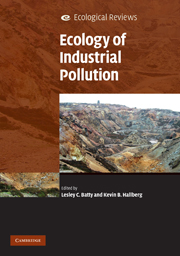Book contents
- Frontmatter
- Contents
- List of contributors
- Preface
- Acknowledgements
- 1 Consequences of living in an industrial world
- 2 Metallophytes: the unique biological resource, its ecology and conservational status in Europe, central Africa and Latin America
- 3 Lichens and industrial pollution
- 4 The impacts of metalliferous drainage on aquatic communities in streams and rivers
- 5 Impacts of emerging contaminants on the environment
- 6 Ecological monitoring and assessment of pollution in rivers
- 7 Detecting ecological effects of pollutants in the aquatic environment
- 8 With the benefit of hindsight: the utility of palaeoecology in wetland condition assessment and identification of restoration targets
- 9 An ecological risk assessment framework for assessing risks from contaminated land in England and Wales
- 10 Diversity and evolution of micro-organisms and pathways for the degradation of environmental contaminants: a case study with the s-triazine herbicides
- 11 The microbial ecology of land and water contaminated with radioactive waste: towards the development of bioremediation options for the nuclear industry
- 12 The microbial ecology of remediating industrially contaminated land: sorting out the bugs in the system
- 13 Ecological recovery in a river polluted to its sources: the River Tame in the English Midlands
- 14 Manchester Ship Canal and Salford Quays: industrial legacy and ecological restoration
- 15 Large-scale mine site restoration of Australian eucalypt forests after bauxite mining: soil management and ecosystem development
- 16 Sustaining industrial activity and ecological quality: the potential role of an ecosystem services approach
- Index
- Plate section
- References
15 - Large-scale mine site restoration of Australian eucalypt forests after bauxite mining: soil management and ecosystem development
Published online by Cambridge University Press: 05 June 2012
- Frontmatter
- Contents
- List of contributors
- Preface
- Acknowledgements
- 1 Consequences of living in an industrial world
- 2 Metallophytes: the unique biological resource, its ecology and conservational status in Europe, central Africa and Latin America
- 3 Lichens and industrial pollution
- 4 The impacts of metalliferous drainage on aquatic communities in streams and rivers
- 5 Impacts of emerging contaminants on the environment
- 6 Ecological monitoring and assessment of pollution in rivers
- 7 Detecting ecological effects of pollutants in the aquatic environment
- 8 With the benefit of hindsight: the utility of palaeoecology in wetland condition assessment and identification of restoration targets
- 9 An ecological risk assessment framework for assessing risks from contaminated land in England and Wales
- 10 Diversity and evolution of micro-organisms and pathways for the degradation of environmental contaminants: a case study with the s-triazine herbicides
- 11 The microbial ecology of land and water contaminated with radioactive waste: towards the development of bioremediation options for the nuclear industry
- 12 The microbial ecology of remediating industrially contaminated land: sorting out the bugs in the system
- 13 Ecological recovery in a river polluted to its sources: the River Tame in the English Midlands
- 14 Manchester Ship Canal and Salford Quays: industrial legacy and ecological restoration
- 15 Large-scale mine site restoration of Australian eucalypt forests after bauxite mining: soil management and ecosystem development
- 16 Sustaining industrial activity and ecological quality: the potential role of an ecosystem services approach
- Index
- Plate section
- References
Summary
Introduction
Mining is essential to provide the resources for modern industrial societies but can result in a catastrophic destruction of pre-mining ecosystems. In Australia, these are often natural ecosystems, commonly pristine and with significant endemism in the flora and fauna. In all cases, the mining of bauxite ore in Australia occurs in areas covered by eucalypt forests or open woodland. Five major bauxite mines are in operation in Australia and these are (from NE to SW) Weipa (Rio Tinto) where the natural vegetation is an open Eucalyptus tetradonta (Darwin Stringybark) woodland, Gove (Rio Tinto), a mixed E. tetradonta and E. miniata woodland (both adjacent to the Gulf of Carpentaria) and Huntly, Willowdale (Alcoa) and Boddington (Worsley) mining in the unique E. marginata (Jarrah) forest region of Western Australia (Fig. 15.1).
Bauxite mining is an important economic activity for Australia, and it is an industry in which it leads the world. Australia is the world's largest bauxite producer, mining 40% of the world's bauxite ore. Australia's aluminium industry is worth over $7.8 billion (in 2004) in export earnings and employs over 16,000 people directly and many more in associated service industries. Australia has, therefore, made the decision to sacrifice some of its unique forested areas in order to maintain economic prosperity for its people.
In order to minimise the negative effect of bauxite mining, typically a form of strip mining or open cast mining, stringent measures (including financial instruments) have been put in place by the state and federal governments whereby the mining companies are required to restore the natural forest into sustainable ecosystems that reflects the original forest prior to mining as much as possible.
- Type
- Chapter
- Information
- Ecology of Industrial Pollution , pp. 309 - 326Publisher: Cambridge University PressPrint publication year: 2010
References
- 14
- Cited by



